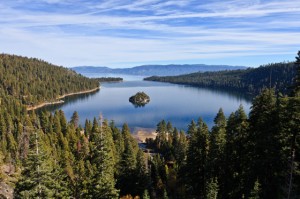
Lake Tahoe, on the border of California and Nevada, is North America's largest alpine lake. Like most other lakes in the world, it's warming up. (Photo by NASA)
The world’s major lakes have been warming at a “rapid” rate since 1985, according to a survey released this week by the National Aeronautics and Space Adminstration (NASA). Using data from infra-red sensors mounted on satellites, the study found average surface-temperature warming in large lakes around the world of up to one degree Celsius (1.8 degrees Fahrenheit) per decade.
While that rate of warming may qualify as “rapid” only among climatologists, its implications range from dire in the long term — a few decades out — to worrying in the near term — a few years out. The web of life as we know it, on which we have balanced our massive industrial infrastructure, can persist as we expect it to persist only within a very narrow range of temperatrures. As lakes get warmer, a cascading set of consequences ensues:
- Warmer temperatures stimulate the growth of algae, which today are plaguing an increasing number of lakes (and rivers) with toxic blooms and/or surface mats. The surface mats prevent the penetration of sunlight, killing the plants underneath them and denying fish and other creatures a major source of food. When the algal mats die and decompose, they suck all the oxygen out of the water, leaving a dead zone.
- Slight temperatuire changes can provide conditions that are tilted in favor of invasive plants, such as Eurasion milfoil in the northern U.S., to the detriment of established native growth. The result can be destabilization of the ecosystem, which means disruption of economic activities based on the status quo.
- Warmer water, in warmer air, evaporates faster, with the result, usually, that lake levels drop. When the lake is Lake Lanier or Lake Meade, which provide the water supply for metro Atlanta and Las Vegas, respectively,. this trend does not have to proceed very far before it becomes catastrophic. The ongoing drop in the levels of the Great Lakes, consistent since 1973, raises concern about the source of drinking water for 40 million people, and poses a clear and present danger to lake navigation by commercial ships and barges.
Information such as the lastest NASA study, based on rigorous science supported by amazing technology, could be used to inform a massive, focused national effort to prevent the destabilization of the world. Instead it is being presented to a government dominated by newly elected and newly energized political leaders whose rise to power required them to portray climate change as a hoax and to deny the existence of evolution.
As Paul Krugman wrote in the New York Times at the conclusion of one of his increasingly gloomy columns about the economic outlook, it would be good to say something optimistic at this point. Unfortunately it does not come to mind.